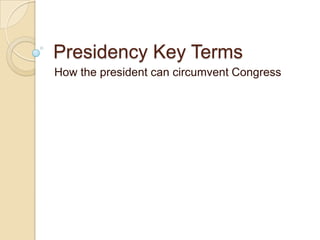
How can the president circumvent congress
- 1. Presidency Key Terms How the president can circumvent Congress
- 2. Executive Orders an order or directive issued by the head of the executive branch at some level of government. U.S. Presidents have issued executive orders since 1789, usually to help officers and agencies of the executive branch manage the operations within the federal government itself. there is no constitutional provision or statute that explicitly allows them, though there is a vague grant of "executive power" given in Article II, Section 1of the Constitution, and furthered by the
- 3. Executive Orders Until the 1950s, there were no rules or guidelines on how to use them The Supreme Court ruled in Youngstown Sheet & Tube Co. v. Sawyer (1952) that EO 10340 from Truman placing all steel mills in the country under federal control was invalid because it attempted to make law, rather than clarify or act to further a law put forth by the Congress or the Constitution. Presidents since this decision have generally been careful to cite which specific laws they are acting under when issuing new executive orders.
- 4. Executive Orders One extreme example of an executive order is EO 9066, where F.D. Roosevelt delegated military authority to remove any or all people (used to target specifically Japanese Americans and German Americans) in a military zone. The authority delegated to General John L. DeWitt paved the way for all Japanese-Americans on the West Coast to be sent to
- 5. Signing Statements A signing statement is a written pronouncement issued by the President of the United States upon the signing of a bill into law. There was controversy over the G.W. Bush’s use of signing statements, which critics charged was unusually extensive and modified the meaning of statutes. In July 2006, the American Bar Association stated that the use of signing statements to modify the meaning of duly enacted laws serves to "undermine the rule of law and our constitutional system of separation of powers". Not mentioned in the constitution that he can alter meaning of law. When a bill is presented to the President, the constitution provides 3 choices: do nothing, sign the bill, or (if he disapproves of the bill) veto it in its entirety and return it to the House in which it originated, along with his written objections to it.
- 6. Signing Statements Until the 1980s, signing statements were generally triumphal, rhetorical, or political proclamations and went mostly unannounced. Until Reagan, only 75 statements had been issued; Reagan and his successors George H. W. Bush and Bill Clinton produced 247 signing statements among the three of them. By the end of 2004, George W. Bush had issued 108 signing statements containing 505 constitutional challenges. As of January 30, 2008, he had signed 157 signing statements challenging over 1,100 provisions of federal law. Some opponents have said that he in effect
- 7. Example The signing statement associated with the Detainee Treatment Act of 2005, prohibiting cruel, inhuman and degrading treatment of detainees in U.S. custody attracted controversy: "The executive branch shall construe... the Act, relating to detainees, in a manner consistent with the constitutional authority of the President to supervise the unitary executive branch and as Commander in Chief and consistent with the constitutional limitations on the judicial power...."
- 8. Executive Agreements An agreement made between the executive branch of the U.S. government and a foreign government without ratification by the Senate. Less formal than a treaty and is not subject to the constitutional requirement for ratification by two-thirds of the U.S. Senate. The Constitution does not specifically give a president the power to conclude executive agreements. However, he may be authorized to do so by Congress, or he may do so on the basis of the power granted him to conduct foreign relations. Despite questions about the constitutionality of executive agreements, in 1937 the Supreme Court ruled that they had the same force as treaties. Because executive agreements are made on the authority of the incumbent president, they do not necessarily bind his successors.
- 9. Examples For example, after the outbreak of World War II but before American entry into the conflict, President Franklin D. Roosevelt negotiated an executive agreement that gave the United Kingdom 50 overage destroyers in exchange for 99-year leases on certain British naval bases in the Atlantic. The use of executive agreements increased significantly after 1939. Prior to 1940 the U.S. Senate had ratified 800 treaties and presidents had made 1,200 executive agreements; from 1940 to 1989, during World War II and the Cold War, presidents signed nearly 800 treaties but negotiated more than 13,000 executive agreements. Clinton authorised the Comprehensive Test Ban agreement with other states in 1999, even though the treaty had failed to ratified in the